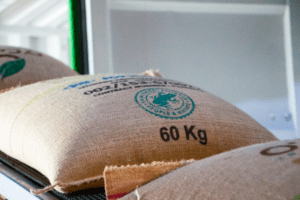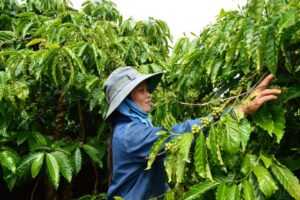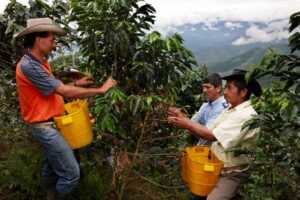MILAN – Miguel Gamboa, Sector Lead, Coffee at the Rainforest Alliance answered a few questions to explain the dynamics behind the certification at origin. This is a topic that is rather discussed throughout the supply chain and is also particularly topical in terms of consumer perception at the time of purchase.
What are the current criteria by which Rainforest attributes its seal to a coffee at its origins?
“By providing a practical framework for sustainable agriculture, and a targeted set of innovations, our certification program can help farmers adapt to climate change, increase their productivity, set goals to achieve their sustainability performance and target investments to address their greatest risks.
Our farm requirements are designed to support certificate holders to maximize the positive social, environmental, and economic impact of agriculture, while offering farmers an enhanced framework to improve their livelihoods and protect the landscapes where they live and work.

Farms and businesses that participate in our certification program are audited against rigorous sustainability standards based on the triple bottom line: environmental, economic, and social well-being.
The criteria for awarding this seal include, but are not limited to:
– Climate-Smart Agriculture: Farmers are trained in eco-friendly practices that help enhance yields, promote ecological balance, and adapt to climate change.
– Innovations: The program encourages innovations such as digital record-keeping and
requires coffee buyers to invest in more sustainable production.
– Continuous Improvement: Farmers are incentivized to enhance sustainability practices
overtime.
– Human Rights: Child and forced labor prevention and workers’ rights are central, with a
focus on community engagement and improvement.
– Balancing Farmers’ Needs with the Supply Chain the Rainforest Alliance’s Shared Responsibility approach seeks to more evenly distribute the benefits and responsibilities of
certification:
– Sustainability Differential (SD): An extra payment to certified farmers, rewarding
sustainable practices.
– Sustainability Investments (SI): Investments by buyers into farm certificate holders to support sustainable farming and compliance with standards.”
Who set these standards (were they created by those in the consuming or producing countries?) and can they be applied uniquely to any production area?
“The current Rainforest Alliance standards were developed, updated, and improved as part of the organization’s 2020 Certification Program. The standards, including the Farm Requirements and the Supply Chain Requirements, are designed to provide a framework for sustainable agriculture that benefits farmers, workers, and businesses involved in agricultural production.
The standards can be applied to various production areas and are meant to assist certificate holders with implementation by providing clarifications and evidence required for compliance. They are designed to support both smallholders and large producers, with differentiation in requirements to focus on issues most relevant to each producer type.
The creation of these standards involves stakeholders from both consuming and producing countries to ensure a comprehensive and inclusive approach that addresses the needs and challenges of all parties involved in the supply chain. The Rainforest Alliance’s approach is global, aiming to deliver value to millions of farmers and workers and thousands of businesses worldwide.”
How difficult and expensive is it for small farmers to be able to meet your standards?
“Meeting the Rainforest Alliance standards can be challenging for smallholder farmers due to the need for implementing more sustainable practices and managing certification processes. However, the Rainforest Alliance has designed its 2020 Certification Program to be supportive of smallholders.

The program differentiates between small and large farms, recognizing that small farms primarily rely on family labor and may not afford individual certification. Therefore, small farmers often use group certification, which allows them to share the burden of record development and keeping.
As for the costs, farmers are responsible for covering all expenses associated with meeting the Sustainable Agriculture Standard. This may include modifying parts of their farm to comply with environmental requirements, adopting new management practices, or constructing new infrastructure. The specific costs can vary widely depending on the farm’s existing practices and infrastructure.
For example, the extent to which internal management systems or grievance mechanisms are already in place in some form, or whether member registries are already digitalized.
The Rainforest Alliance certification can also lead to several revenue benefits for farmers:
– Increased Productivity: The certification encourages practices that can maximize a
farm’s healthy productivity, which may result in higher yields and better-quality crops.
– Access to New Markets: Certification can open up new markets that are only accessible
to products that meet certain sustainability standards.
– Additional monetary payments made to individual certified farmers, on top of the
market price of the commodity to reward them for implementing more sustainable
agricultural practices.
– Cost Reduction: Where farmers are applying the principles of integrated pest
management and using pesticides as a last resort, farmers can reduce the use of
pesticides and thus reduce costs.
– Long-term Sustainability: More sustainable and regenerative practices can lead to better
soil health and climate and farm resilience, helping to ensure long-term productivity and
revenue.
Overall, while there are challenges and costs involved, the Rainforest Alliance aims to provide a framework that supports farmers in improving their livelihoods and sustainability performance, with a focus on making certification accessible even for smallholder farmers.”
Do you have support operations for farmers who want to obtain your seal?
“Yes, the Rainforest Alliance provides comprehensive support for farmers seeking to obtain the Rainforest Alliance certification. We offer a range of resources, including:
– Online Resources: Detailed FAQs, guidance documents, and access to trainers who can
help with the implementation of the Sustainable Agriculture Standard.
– Training: Courses to get an in-depth understanding of the Sustainable Agriculture Standard and certification system.
– Authorized Certification Bodies: Assistance in finding authorized certification bodies in your country.
For a step-by-step guide on the certification process, you can refer to our guide for farmers. It’s available in twelve languages and includes information on preparing for an audit, finding a certification body, hosting a farm audit, and selling Rainforest Alliance Certified crops.”
What are the main differences between your seal and that of other major organizations instead, such as Fairtrade, Organic Coffee?
“All three schemes work towards sustainability, but they differ in their focus and approach. We encourage you to do further research to gain a deeper understanding of each certification’s principles and impacts, as we may not possess the most up-to-date information regarding other schemes.
As for our own focus, Rainforest Alliance certification emphasizes a holistic approach to
sustainability, integrating social, economic, and environmental aspects across the entire value chain from seed to consumer by transforming land-use practices, business practices, and consumer behaviour.

It aims to improve the lives of farmers and forest communities by promoting more sustainable farm management, financial literacy, and market access. We are also promoting a shared responsibility approach that encourages companies buying Rainforest Alliance commodities to do their part as well.”
Have things changed or will they change from the influence of the EUDR?
“The Rainforest Alliance has indeed made changes to help companies meet compliance with the European Union Deforestation Regulation (EUDR), and support farmers to adapt to the new equirements.
The Rainforest Alliance has been working to tackle tropical deforestation in global supply chains for more than 35 years. Traceability has always been the backbone of that approach. Building on these foundations, we have further aligned our certification program with the EUDR’s requirements, particularly for cocoa and coffee products. We are helping farmers collect and process crucial geo-coordinates for their farms and provide tools and systems like automated risk assessment maps (using a combination of sources including proprietary AI remote sensing forest data) for deforestation, which can help companies show compliance with EUDR requirements at no extra cost.
We are also developing an EUDR offering for non-certified supply chains.
The objective is that by December 30, 2024, all supply chain stakeholders will have the option to identify farm Certificate Holders who have selected the EUDR criteria in the Rainforest Alliance Certification Platform. This will enable traceability and provide the necessary data to support compliance with the EUDR obligations.
As part of our ongoing Advocacy work, the Rainforest Alliance has called for more support for smallholder farmers to ensure they are not unintentionally excluded from the EU market.”
From when you started to now, has getting certifications become more of a focus for consumers, producers, or importing companies?
“Yes, certifications have become increasingly important for consumers, producers, and importing companies. Overall, sales of Rainforest Alliance certified coffee have shown a long-term growth trend, with a 40% increase overall since 2017. Consumers want to know that products meet certain standards for sustainability, and certifications help provide that assurance.
Producers see certifications as a way to switch to better practices, improve their products’ reputation and appeal to a wider audience. Importing companies often opt for certifications to help mitigate risks in their supply chain, help meet compliance with regulations, and meet consumer preferences.
Overall, the emphasis on certifications has risen steadily due to consumer demand and industry efforts to stay competitive.”
How many farmers to date are part of your network? Do you have any new goals to reach in terms of involvement?
“As of the latest available data, the Rainforest Alliance network includes 7.5 million farmers and workers on certified farms, covering over 6 million hectares of certified farmland across 58 countries. The final numbers are still being processed and will be part of our 2023 annual report.
The Rainforest Alliance’s 2030 strategy is to accelerate the speed and scale of impact through a virtuous cycle with producers at the heart. More sustainable farmers lead to more committed companies and consumers, leading to more investment and support for farmers, and so on.
We plan to build on the foundations of our certification program and are particularly focusing on scaling up the implementation regenerative agricultural practices that reestablish lost ecosystem functions and improve the existing ones.
Regenerative agriculture has the potential to make a tremendous contribution not only to climate change adaptation, but also to biodiversity conservation, sustainable livelihoods, healthier workers, and the environment.
For the rural producers we partner with, and the critical landscapes where we work, regenerative agriculture is integral to the wider regenerative movement. Supporting farmers to make the transition is an important step so that people and nature can thrive in harmony.”
What do you ask a farmer to join your association?
“The Rainforest Alliance brings together millions of people from frontline rural communities, leading companies, international governments, NGO partners, and dedicated supporters from around the world. Together we are using social and market forces to protect nature and improve the lives of farm and forest communities. Farmers are part of this alliance in different ways, one of which can be through becoming certified under the rainforest alliance standard.
To join the Rainforest Alliance network, farmers are required to comply with the 2020 Sustainable Agriculture Standard. This includes a set of Farm Requirements designed to support sustainable agriculture practices and improve livelihoods while protecting the landscapes where they live and work.
A full guide for the farmers is available here.
The guide is extensive, and the Rainforest Alliance provides a framework and different sorts of support to help farmers to comply and improve.
Here are some key themes covered in the standard:
– Environment: Farmers must adopt practices that protect standing forests, prevent the
expansion of cropland into forests, and foster the health of trees, soils and waterways.
– Climate: Our certification programs promote responsible land management methods that
increase carbon storage while avoiding deforestation, which fuels greenhouse gas emissions.
The climate-smart practices embedded in our agricultural training and certification programs help farmers to build resilience to droughts, flooding, and erosion.
– Human rights: While acknowledging that certification cannot fully eliminate human rights abuses, our standards include robust strategies for assessing and addressing issues such as child labor, forced labor, poor working conditions, low wages, gender inequality, and
violations of Indigenous land rights.
– Livelihoods: Our strategy recognizes the interdependence of ecosystem health and rural
economic stability. Improving sustainable livelihood opportunities for smallholder farmers
and forest communities is the most effective way to lift rural people out of poverty, and
certification has proven to bring measurable financial benefits to farmers and forest
communities around the world.
And additionally:
1. Continuous Improvement: There’s an expectation to keep getting better over time, like reducing chemical use and improving waste management.
2. Audit Preparation: Farmers have to get ready for an audit, which is like a detailed inspection to make sure they’re following all the rules.
3. Geolocation Data: They need to provide specific location data of their farm, which helps in monitoring and verifying their practices.”
How has the concept of sustainability evolved over the years, from niche to the mainstream?
“Sustainability has transitioned from a niche concern to a mainstream imperative, driven by
heightened environmental awareness, robust scientific evidence, evolving consumer preferences, growing corporate responsibility, and important regulatory shifts such us the EU anti-deforestation regulation.
The Rainforest Alliance’s founding principles in 1987 laid the groundwork for promoting
sustainability. The introduction of our certification programs incentivized and recognized more sustainable farming practices, while our current global reach across nearly 60 countries enabled these practices to spread to millions of farmers worldwide, contributing to a widespread adoption of sustainability in agriculture. Today, millions of consumers around the world can find the Rainforest Alliance seal on over 54,000 of their favourite products.
Given the planet’s current state, we however believe a ‘do no harm’ sustainability mindset is no longer enough. We need to move to a ‘repair and restore’ regenerative mindset, which is why the Rainforest Alliance is supporting farmers and companies to transition to regenerative agriculture.
While sustainable agriculture helps reduce the harm caused to ecosystems by conventional
agriculture, regenerative agriculture aims to go a step further, to reestablish lost ecosystem
functions, and improve existing ones. By investing in soil health and biodiversity in harmony with local ecosystems – a regenerative farm is better able to provide many important ecosystem services, such as water filtration, pollination and carbon sequestration.”


















